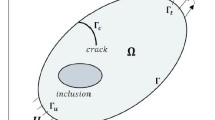Abstract
In the present paper a simulation method is proposed for the evaluation of paths and lives of fatigue cracks. The simulation is based on an incremental crack extension procedure. At each increment the stress analysis ahead of a crack tip is carried out by the finite element method, and the next incremental crack-growth path is predicted by the first order perturbation method with the use of the local symmetry criterion. From the computational viewpoint, the step-by-step rezoning of finite element mesh subdivision is one of the most difficult processes of the simulation procedure. In order to overcome this difficulty, we shall use the modified quadtree method as an automatic mesh generation technique. Considerations are made for the proper mesh arrangement in the vicinity of a crack tip, where a special fine mesh pattern is embedded so that mixed mode stress intensity factors and the higher order coefficients of the near tip stress field parameters can accurately be obtained. Using the proposed method, we simulate the branched and curved fatigue crack growth in three-point-bending specimens. They show fairly good agreement with the experimental results. The simulation procedure is also applied to biaxially loaded cruciform joints.
Similar content being viewed by others
References
M., Higuchi, M., Kawahara, K., Kondo and M., Kurihara. Journal of the Society of Naval Architects of Japan 139 (1976) 221–226 (in Japanese).
A.R., Ingraffea and F.E., Heuze. International Journal of Numerical and Analytical Methods in Geomechanics, 4 (1980) 25–43.
Y., Sumi. Theoretical and Applied Fracture Mechanics 4 (1985) 149–156.
Y., Sumi. International Journal of Fracture 44 (1990) 189–207.
Y. Murakami. Proceedings of the International Conference on Analytical and Experimental Fracture Mechanics, Rome (1980) 871–882.
H., Horii and S., Nemat-Nasser. Journal of Geophysical Research 90-B4 (1985) 3105–3124.
A., Portela and M.H., Aliabadi. Crack Growth Analysis Using Boundary Elements, Computational Mechanics Publisher, Southampton, UK (1992)
Y., Yamamoto and N., Tokuda. International Journal for Numerical Methods in Engineering 6 (1973) 427–439.
Y., Sumi and Y., Yamamoto. Discretization Methods in Structural Mechanics, Springer, Berlin (1990) 243–252.
Y., Sumi, S., Nemat-Nasser and L.M., Keer. International Journal of Fracture 21 (1983) 67–79; Erratum International Journal of Fracture 24 (1984) 159.
Y., Sumi. Engineering Fracture Mechanics 24 (1986) 479–481.
M.A. Yerry and M.S. Shephard. IEEE Computer Graphics and Applications Jan./Feb. (1983) 39–46.
F., Erdogan and G.C., Sih. Journal of Basic Engineering 85 (1963) 519–527.
G.C., Sih. Mechanics of Fracture, 1, Noordhoff, Leyden (1972).
C.H., Wu. Journal of Applied Mechanics 45 (1978) 553–558.
N.V., Banichuk. Mekhanika Tverdogo Tela (7) 2 (1970) 130–137 (in Russian).
R.V., Goldstein and R.L., Salganik. International Journal of Fracture 10 (1974) 507–527.
H. Kitagawa, R. Yuuki, K. Tohgo and M. Tanabe. Multiaxial Fatigue, ASTM STP 853 (1985) 164–183.
S., Nemat-Nasser and H., Horii. Journal of Geophysical Research (87) B8 (1982) 6805–6821.
H.F., Bueckner. Mechanics of Fracture, 1, Noordhoff, Leyden (1972) 239–314.
M.A., Amestoy and J.B., Leblond. International Journal of Solids and Structures 29 (1992) 465–501.
E.W. Smith and K.J. Pascoe. Multiaxial Fatigue, ASTM STP 853 (1985) 111–134.
R.E. Link. Advances in Multiaxial Fatigue, ASTM STP 1191 (1993) 345–358.
Author information
Authors and Affiliations
Rights and permissions
About this article
Cite this article
Sumi, Y., Yang, C. & Hayashi, S. Morphological aspects of fatigue crack propagation Part I—Computational procedure. Int J Fract 82, 205–220 (1996). https://doi.org/10.1007/BF00013158
Received:
Accepted:
Issue Date:
DOI: https://doi.org/10.1007/BF00013158




